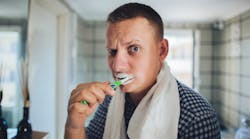I’ll never forget the time I was part of career day at the local elementary school. I got up in front of a group of third graders, hoping to engage them in careers in the dental industry. To keep it exciting, I showed them a video about how the plaque on their teeth was alive. Well, one poor girl had to be ushered to the guidance counselor after having a massive breakdown. Whoops! I’m guessing dentistry is not the career for her.
While the thought of that stuff on your teeth being alive might also gross you out, I want it to empower you to take ownership of your oral health. The glorious thing here is you are in control of this. With the right tools and treatments, you can turn that gunk from disease-producing to a benign layer of film that’s easy to remove.
First off, what is that stuff?
Scrape your front tooth with your fingernail. See that? That’s biofilm. Biofilm in the mouth is a collection of single-celled organisms that live together in a group structure. It’s a compound word, bio meaning living, and film referring to the clingy matrix that holds it together. The phrase “there’s strength in numbers” really fits here. When all these organisms band together, it changes the way they function. They become a mob and cause destruction that they couldn’t do all by themselves.
We now have strong science that links certain bacteria to increased risk of stroke, Alzheimer’s disease, heart disease, osteoporosis, respiratory issues, diabetes, cancer, rheumatoid arthritis, pregnancy complications, erectile dysfunction, and more. So that stuff on your teeth can do waaaay more than just cause bad breath.
How’d it get there?
Most likely, the biofilm started forming when you were a little baby. The first time your mom licked your pacifier, or your great aunt Edna gave you a sloppy kiss on the lips, it introduced the bacteria from their oral biofilm into your mouth. Your oral biofilm started to establish itself, even before teeth appeared.
How does it grow?
Your biofilm eats when you do. Bacteria loves sugar, added and natural alike. The more often you eat and drink, the more your biofilm eats and drinks. And the more sugars in your food, the easier it is for the biofilm to chow down. Each time you introduce anything but plain water into your mouth, your pH drops. Some of the most destructive bacteria love a low pH and can multiply faster than flies at a picnic.
That pesky biofilm starts to regrow 24 hours after it is removed. That’s why you can’t blast it away once and be in the clear. And by the way, not all biofilm is bad. We’ve heard of good bacteria, right? You can actually have a biofilm that isn’t destructive and doesn’t cause cavities or gum disease or lead to other diseases like Alzheimer’s, rheumatoid arthritis, heart disease, and impotence. So our goal is to manage that biofilm.
What do you do?
Here’s the good news. Remember I said you are in control of this? Well, maybe not all by yourself. But your dental team is ready to help you learn how to battle that biofilm. And this is why you can’t just brush your teeth REALLY well the morning of your hygiene appointment and “fool” your hygienist.
I was recently at a happy hour, and when it came up that I’m a hygienist, the conversation turned to their last dental appointment. This person told me how much she preferred the “scrapey instruments” over the “water thing.” Well, while the scrapey instruments are suitable for removing the hard deposits, like tartar, “the water thing,” also known as the power scaler, actually helps break down the biofilm. And an even better “water thing” is guided biofilm therapy with an air polisher. It uses a small particle powder that can disrupt the biofilm on your teeth, under your gums, and even on your tongue!
There are even ways to test your biofilm and pH to determine your risk factors and the best treatments for you. Some of these you can do, and others your dental team can administer. Understanding what’s happening in your mouth will go a long way to maintaining a healthy biofilm.
At home, it’s your job to disrupt that biofilm. We talked about the mob mentality. If you can keep scrambling that bacteria, they won’t have the opportunity to band together and cause destruction. Brushing with a power toothbrush, with proper technique, for at least two minutes twice a day will help clean the flat surfaces of your teeth. Then get in between your teeth with something. In “I’m sorry I nagged you about flossing,” I talked about floss, interdental brushes, water flossers, and more.
I encourage you to engage your hygienist in this conversation. Let them know you want to learn to take care of your teeth properly. Ask questions. We love it! Quite often, we feel rushed in our appointment to get all the care accomplished. Slow us down and let us know you’re interested. Let’s get curious together on how to manage your biofilm and get you on the path to lifelong health.
AMANDA HILL, BSDH, RDH, a practicing dental hygienist, industry educator, and key opinion leader, is passionate about the dental industry. She is a speaker, award-winning author, and host of Your Dental Top 5 podcast. A member of the advisory board for RDH magazine and OSAP’s Infection Control In Practice Editorial Review Board, Amanda strives to make topics in dentistry accurate, accessible, and fun! She can be reached at amandahillrdh.com and [email protected].






